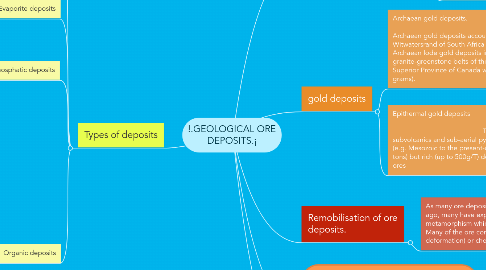
1. Types of deposits
1.1. Placer deposits
1.1.1. These are made of alluvial, colluvial and eluvial material, which contain economic quantities of some valuable minerals
1.2. Clay deposits
1.2.1. These either form by settling of clay particles in sedimentary basins or through intense weathering of volcanic and granitic rocks.
1.2.1.1. Useful clay types include:
1.2.1.1.1. China Clay: deposits of kaolin produced by hydrothermal decomposition or deep weathering of feldspar minerals in granites.
1.2.1.1.2. Fullers Earth: an aluminium-poor montmorillonite clay which is highly absorbent (very useful for absorbing contaminant oil).
1.3. Evaporite deposits
1.3.1. An evaporite is a sediment that forms through the evaporation of saline water. The most common evaporite deposits are salts (most commonly sylvite and halite), gypsum, and nitrates
1.4. Phosphatic deposits
1.4.1. There are three types of this deposit
1.4.1.1. 1. Primary marine phosphate deposits
1.4.1.2. 2. Bone beds
1.4.1.3. 3. Guano:
1.5. Organic deposits
1.5.1. Coal
1.5.1.1. Coal is a general name given to stratified accumulations of carbonaceous material derived from vegetation. The starting material is usually peat or some other form of partially decayed organic material (commonly leaves and branches of trees).
1.5.2. Fireclay
1.5.2.1. Fireclay is a fossil clay-rich soil associated with coal deposits. It is useful as a refractory material.
1.5.3. Oil/petroleum
1.5.3.1. Natural deposits of oil are most commonly found associated with natural gas (which is itself derived from the heating-up of the oil), salt water, and sometimes, solid hydrocarbons. The origin of natural oil is still disputed but most geologists believe that it is derived from organic material by decay. Most natural accumulations of oil appear to have formed under marine conditions (i.e. marine basins) though some has also formed in estuarine and deltaic environments.
1.5.4. Peat
1.5.4.1. Peat is a partially decomposed mass of vegetation that has grown in a shallow lake or marsh. Peat contains recognisable vegetable material but very little mineral material. The main plants which make-up peat are the peat mosses, along with rushes, sedges and horse-tails
1.5.5. Residual deposits
1.5.5.1. Residual deposits are formed in tropical regions. During the wet season, intense leaching of the rock occurs. Then, during the dry season, the solution containing the leached ions is drawn towards the surface by capillary action where it evaporates leaving behind salts that are washed away in the next wet season.
2. Classification and types of mineral deposits
2.1. Geologists classify mineral deposits in many different ways, according to the:
2.1.1. commodity being mined
2.1.2. geological setting of the mineral deposit
2.1.3. tectonic setting in which the deposit occurs
2.1.4. genetic model for the origin of the ore deposit
2.2. tectonic setting in which the deposit occurs
3. gold deposits
3.1. Archaean gold deposits. Archaean gold deposits account for more than 60% of the world's gold. Over 60% of this comes from the Witwatersrand of South Africa (a hydrothermally remobilised palaeo-placer gold deposit) and the remainder from Archaean lode gold deposits in Australia, Canada, southern Africa and South America. The Archaean granite-greenstone belts of the world are characterised by numerous lode gold deposits, the largest of which is the Superior Province of Canada which has produced more than 170 million ounces of gold (a troy ounce is 31.1 grams).
3.2. Epithermal gold deposits They are volcanic-hosted deposits (consisting of both subvolcanics and sub-aerial pyroclastics) that are generally relatively recent in age (e.g. Mesozoic to the present-day). In general, they are small (less than a million tons) but rich (up to 500g/T) deposits which consist of vein systems and bonanza ores
3.2.1. the main minerals are
3.2.1.1. native gold and silver
3.2.1.2. electrum
3.2.1.3. • silica occurring as quartz (most often forming comb-like aggregates), amethyst, opal, chalcedony and cristobalite
3.2.1.4. acanthite and tetrahedrite
4. Remobilisation of ore deposits.
4.1. As many ore deposits formed many hundreds to thousands of millions of years ago, many have experienced numerous episodes of deformation and metamorphism which left them with few characteristics of their original form. Many of the ore components were remobilised (i.e. moved) either by physical (i.e. deformation) or chemical (i.e. dissolution and precipitation) mechanisms.
5. The main types of geological ore deposits of importance can be divided into:
5.1. metallic deposits
5.2. non-metallic deposits
5.3. fossil fuel deposits
6. Oxidised zones of ore deposits
6.1. The region above the water-table in an ore deposit is known as the oxidised zone as it is the zone of oxidation of the primary ore minerals. This oxidised zone is primarily composed of mixtures of iron oxides/hydroxides and quartz which we call gossan.
6.1.1. Most primary ore minerals (particularly the sulfide minerals) are only stable in anaerobic dry environments. With the rise and fall of the water-table and downward percolating rainwater (containing dissolved oxygen), these minerals dissolve and new minerals (oxide zone minerals) are precipitated in the gossan. With the dissolution of sulfide minerals, the water becomes acidic, further enhancing the dissolution of the ore.
